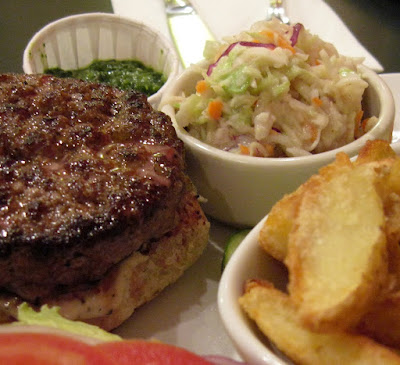Arnold: What's the secret sauce?
Brad: Thousand Island dressing. What's the secret sauce at Bronco Burger?
Arnold: Ketchup and mayonnaise.
I cannot recommend enough Michael Pollan’s book “The Omnivore’s Dilemma.”
Subtitled “A Natural History of Four Meals,” Pollan devote almost 500 pages to exploring food production in America, and the decisions, expenses and unintended consequences that are processed into that system. His website has the best summary of the omnivore’s dilemma.
“The cornucopia of the modern American supermarket and fast-food outlet confronts us with a bewildering and treacherous food landscape. What’s at stake in our eating choices is not only our own and our children’s health, but the health of the environment that sustains life on earth.”
The four meals are simple things. The first is a petroleum-based fast food hamburger and fries purchased at a McDonald’s and eaten in a car heading down the highway at 60 mph. With the second and third meals he examines both an industrial-organic method of food production and visits an intensive-organic farm. For the last meal he reverts to our hunter-gatherer heritage to forage for mushrooms and kill a wild boar.
This book is packed with information and anecdotes, including Pollan’s experience raising a single cow using the industrial method, but the idea that struck a chord with me is how much of our diet is based on corn. On Earth living things are carbon-based, and in order to grow and survive they much consume more carbon. Plants, bacteria, animals and humans are all in competition for efficient methods of gathering and consuming carbon. Corn has an identifiable carbon isotope known as C-13, which allows tracking of that atom of corn up through the food chain from corn to cow to human, or directly from corn to human in the form of high fructose corn syrup, as well as in additives to other processed food, or through the popcorn and breakfast cereals we eat.
In the course of the book he discusses the different methods of production and it’s clear he prefers the intensive-organic, grass-based farming method of food production. The small farm that he visits in the book has a mechanism where the cows graze the grass, which is then followed up with a movable hen house so the birds can clean up the grains the cows missed. The droppings from the animals go back into the ground as fertilizer, and he rotates among his fields so no grass is over-grazed.
There are many reasons to prefer grass-fed beef. In the US grasses are better for the soil, requiring less fertilizer, and they can more often be native plants. Feeding cattle on grass allows them to grow more naturally, slower than a cow fed on corn, but this natural diet keeps them healthier so they won’t need as much antibiotics and medical treatment during their life.
When it comes to taste, some say that the meat from grass-fed cows is more aesthetically pleasing in terms of marbling and fat content. And in the course of producing beef, grass-fed cows are treated less like meat factories, which might ease some people’s consciences.
I’m not saying you have to read “The Omnivore’s Dilemma” before you visit
Dick’s Kitchen, but it helps to appreciate the backstory of the meal waiting for you there.
The website for Dick’s Kitchen says it’s “Portland' 1st Stone Age Diner.” If you’re one of those people who like a restaurant with a philosophy, theirs is written on the menu:
“an emphasis on healthy, lean proteins and fresh vegetables: the type of food our ancestors evolved to eat and that is now considered most in tune with the nutritional physiology that promotes health and a lower risk of metabolic disorders."
The hamburgers were supposed to be hand-made patties, but they were so regular they looked like they were made in a burger press. At five ounces it's slightly more than a quarter pound burger, but the difference is negligible. The basic burger comes on a dairy-free potato bun and with lettuce, tomato, red onion, "home-made" pickles, special sauce and a side of coleslaw. When I ate there you could order a side of "not-fries" for $2, but I notice the online menu shows the price as $2.50. The "not-fries" are baked fries, and are better than the average baked fry.
"Wait!" you say. "What's in the special sauce?"
Dick's Kitchen says they make all of their sauces, and we got a chance to try all of them. Of course they have the standards: ketchup, mustard and mayo. I felt the mustard was nicely zesty, thick enough but not pasty. But those were run-of-the-mill next to the other sauces. The Persilla sauce slightly reminded me of an Indian coriander chutney, which they described as a pesto-like sauce made of parsley, anchovies, garlic and Parmesan. The horseradish sauce could have been spicier, as with the Wasabi aoli. I liked the aoli, which was creamy and had a good taste of Wasabi, but not any of the bite, and found it was good dipping sauce for the burger. The best sauce for the “not fries” was the chipotle aoli. It had a taste which went especially well with the sweet potato “not fries.”
For drinks you can order hand-made sodas for $2, so we enjoyed a watermelon and a root beer, and I ordered a HUB lager from their selection of five taps. The décor was retro-minimalist faux diner with pictures of other famous Dicks on the wall. Because the space echoed it was a bit noisy, and on a Friday night we had to wait about half an hour from the time we ordered until we were served.
Let me tell you honestly: the hamburgers weren’t amazing, but I think the sauces made them enjoyable. Dick’s, however, isn’t about the burgers. It’s a gateway restaurant. In addition to the meaty fare they have a wide range of meatless offerings that look and sound interesting. The menu lists a tempeh Reuben, a Portobello burger, SmartDogs, and vegan salads. Swinging back the other way, they also have heritage meats bratwurst, and a bacon burger with uncured bacon. Oh, and there’s a non-required reading list.
So, what’s the secret sauce? The real secret is that Dick’s Kitchen wants to take you on a journey to change the way you think about your meal, and they're making it taste good on the way.
I’m not joking about the reading list:
FURTHER READING
 According to this article here the House GOP "Spending Reduction Act of 2011" bill would eliminate the National Endowment for the Arts and cut the National Endowment for the Humanities budget by 95% or more.
According to this article here the House GOP "Spending Reduction Act of 2011" bill would eliminate the National Endowment for the Arts and cut the National Endowment for the Humanities budget by 95% or more.





